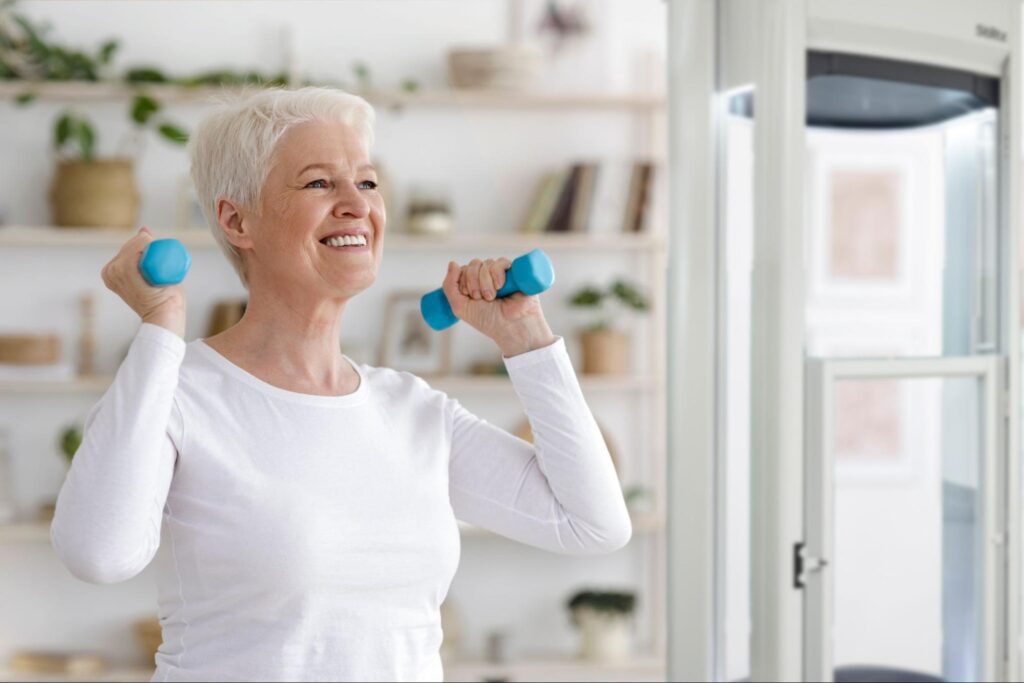Discover easy, arthritis-friendly home adaptations to make daily life more comfortable.
Essential Home Adaptations for Arthritis

Essential Home Adaptations for Arthritis
How to Create an Arthritis-Friendly Home: Key Adaptations for Better Mobility

As we age, daily tasks can become more challenging, especially for those with arthritis. With over 10 million people in the UK affected by this condition, you’re not alone if you find that simple movements cause pain or discomfort. The good news is that there are a wide range of adaptations you can make to your home to help maintain your independence and improve your quality of life.
We’ll walk you through key adjustments to make your home more arthritis-friendly and easier and safer to move around.
How arthritis affects daily life
Arthritis encompasses more than 100 types of joint-related diseases, with osteoarthritis and rheumatoid arthritis being some of the most popular. These conditions can lead to various physical challenges, such as joint pain, swelling, and reduced mobility. The impact can be significant, making simple tasks like walking, climbing stairs, or even getting dressed more difficult.
Some of the common challenges that those with arthritis face include:
- Pain and stiffness — Everyday tasks like getting out of bed, walking, and climbing the stairs can become painful and difficult.
- Reduced range of motion — Arthritis can limit the flexibility of your joints, making it harder to bend, lift, or reach.
- Balance issues — The pain and stiffness can affect your balance, increasing the risk of falls and accidents around the home.
- Fatigue — Chronic pain and discomfort can quickly lead to exhaustion, making it harder to complete daily tasks.
- Dependence on caregivers — As the condition progresses, some individuals may need to rely more on others for assistance with daily activities.
The benefits of home adaptations for arthritis sufferers
Making adaptations to your home can be life-changing as you age, and they are particularly beneficial when you’re living with arthritis. Even small changes in your environment can make a big difference in terms of your quality of life, how you feel, and your ability to maintain your independence day-to-day.
Studies have shown that 95% of arthritis sufferers who make home adaptations find them beneficial to their everyday lives. These adjustments can help prevent accidents, reduce the amount of pain they experience, and make it easier to move around their homes without worrying about bumping into obstacles.
Some of the key benefits of home adaptations for people living with arthritis include:
- Increased safety — Removing hazards, adding grab rails, and improving lighting can all prevent falls and injuries, which are a major concern for people with arthritis.
- Comfort — Adjustable-height furniture and softer flooring can help make everyday tasks more comfortable and less painful by reducing the strain on your joints.
- Enhanced independence — With the right modifications, you’ll be able to carry out daily activities without relying on others.
- Greater confidence — Knowing that your home has been adapted to suit your needs can provide peace of mind, helping you move around with greater ease and comfort.
Essential arthritis-friendly home modifications
If you’re wondering what equipment can help with arthritis, the good news is that there are many gadgets for arthritis sufferers in the UK specifically designed to make everyday tasks easier. Whether it’s improving your mobility, reducing pain levels, or just generally making your home more accessible, these modifications can significantly enhance your quality of life:
Getting in and out of the home
For many people with arthritis, getting in and out of the home can be one of the biggest challenges. Even if the inside of your home is easy to navigate, many properties across the UK have at least a single step leading up to the front or back door — if not several.
If you experience joint pain, stiffness, or reduced mobility, even small steps or thresholds can become significant obstacles.
Here are some simple but effective adaptations to help:
- Ramps — Installing permanent or portable ramps to replace steps at the entrance can make it easier to navigate, particularly if you’re using a walking aid or need a way to make your home wheelchair accessible.
- Non-slip surfaces — Make sure the ramp and paths are made from non-slip materials to prevent falls, particularly in wet weather.
- Grab rails — Install sturdy grab rails at key points, such as near the door or along any paths leading up to your home. This helps to reduce the weight on your joints and gives you something to lean on when needed.
- Wider doorways — If mobility aids are needed, wider doorways can help make entry and exit smoother, reducing the risk of bumping into door frames or struggling to pass through.
Adaptations for the bathroom
The bathroom can be one of the trickiest rooms for those with arthritis. When you struggle with limited joint mobility, the tasks we usually take for granted — like getting in and out of the bath or standing to use the toilet — can become difficult and may even come with tripping risks.
Thankfully, there are plenty of simple adaptations that can make your bathroom more accessible and comfortable to use.
Here are some essential modifications to consider:
- Level-access shower — A level-access shower or wet room removes the need to step into a bath or shower, reducing the risk of trips and falls.
- Lever taps — Replacing traditional pillar taps that can be difficult to control with easy-to-use lever taps can make turning the water supply on and off easier for those with hand and wrist pain.
- Accessible storage — Keep any toiletries and other bathroom essentials at waist height in an open storage unit to avoid unnecessary bending or reaching. Swapping out regular shampoo bottles with pump-action alternatives may also be helpful.
- Grab rails — Install grab rails near the toilet, shower, and bath to offer extra support and make standing up or sitting down much safer.
- Toilet seat risers — Consider adding a toilet seat riser to make sitting and standing more comfortable. Some models also come with arms for additional support when sitting down and standing up.
- Non-slip mats — Add non-slip mats or rugs to the floor, especially near areas that get wet often, such as around the bath, shower, or sink, to prevent slipping.
Adaptations for the kitchen
The kitchen is one of the most frequently used rooms in the home, but it can also be a problem area for people with arthritis. Tasks like cooking, washing dishes, and reaching for items on high shelves can become difficult if joint mobility is limited. The good news is that with a few clever modifications, you can make your kitchen more comfortable and accessible.
Here are some kitchen adaptations to consider:
- Lever taps — These taps aren’t just a helpful addition to the bathroom. Replacing your traditional kitchen taps with lever-operated ones can make a big difference for people with arthritis. These are easier to turn on and off with limited hand strength.
- Lowered counters — Having your kitchen counters fitted at a comfortable height (31-34 inches) can prevent the need to reach up or bend down, reducing the strain on your back.
- Pull-out shelves and drawers — Install pull-out drawers and shelves instead of traditional cabinets to make it easier to reach frequently used items without straining your joints.
- Eye-level oven — An eye-level oven reduces the need to bend down when cooking, making it safer and more accessible for those with arthritis.
- Non-slip flooring — Make sure your kitchen floor has a non-slip coating to prevent any accidents. This is especially important if you rely on walking aids or tend to lose balance.
- Ergonomic utensils and gadgets — Invest in arthritis-friendly utensils with cushioned handles, such as knives, can openers, and peelers. These make cooking tasks much easier without straining your fingers.
- Kettle tippers and easy-grip appliances — Gadgets like kettle tippers and spring-loaded scissors can reduce the effort required for everyday tasks.
Adaptations for the bedroom
The bedroom should be a space to relax and unwind at the end of the day, but for those with arthritis, it can become a challenge to navigate — especially when stiffness and joint pain are usually at their worst in the morning. Adjusting your bedroom setup can help reduce strain and make daily routines, such as getting in and out of bed or getting dressed, much easier.
Here are some bedroom adaptations to consider:
- Higher bed — Investing in a bed that is slightly higher than the average can make it easier to get in and out, reducing strain on your hips, knees, and back. You may also want to consider using a mattress topper for extra height and comfort.
- Easy-to-reach storage — Make sure any items you use regularly, like clothes, bedding, and nightwear, are all within easy reach. Installing shelves or using storage bins that slide out from under the bed can reduce the need for bending or stretching.
- Glide-action wardrobe doors — Sliding doors are easier to use if you have limited hand strength. Glide-action wardrobes can be a simple yet effective way to make accessing your clothes more convenient.
- Touch-sensitive or motion-activated lighting — Touch-sensitive lamps or motion-activated lights can be easier to operate, especially when getting up at night, meaning there’s no need to fumble around for a light switch.
- Support rails — Install support rails next to the bed and any other areas where balance may be a concern. These offer extra stability when moving about or getting dressed.
Moving around the home
Arthritis can make it challenging to make the most of your home, whether it’s moving between rooms or getting from one floor to another. Even simple tasks like walking down the hall or climbing the stairs can feel challenging, so it’s important to make sure your living space allows you to move around safely.
Here are some key adaptations to consider for improving mobility within your home:
- Keeping pathways clear — Keep hallways and rooms free from clutter to allow you to move around easily. Arrange your furniture in a way that creates an open and clear pathway, making sure there’s no risk of tripping or knocking into obstacles.
- Fitting handrails and grab bars — Install sturdy handrails along stairways and in areas where you may need extra support, such as the bathroom or kitchen.
- Choosing sturdy furniture — Consider investing in soft furniture with higher backs and armrests, making standing up and sitting down easier.
- Laying non-slip flooring — If your home has hard flooring, adding non-slip rugs or mats can help to reduce the slip hazard, especially in areas like the bathroom or kitchen. Replacing tiles with more textured flooring might also be necessary to improve safety.
- Installing a home lift — For those struggling with using the stairs, installing a home lift is a fantastic way to move between floors without the strain and risk. A lift allows you to choose whether to travel seated or standing, reducing the discomfort that comes with alternative options like stair lifts.
Make movement simple with Stiltz
Managing arthritis can make everyday tasks like climbing stairs challenging. A Stiltz Home Lift provides a reliable solution to help you move smoothly between floors, whether you’re standing or seated.
Explore our range of lifts, including the standard Duo model and the wheelchair-friendly Trio, designed to boost your home’s accessibility. Contact us today to find the perfect lift for your needs and make moving around your home easier, or take a look at our blog for more inspiration on ageing in place.
Customer Testimonials
My experience with Stiltz Homelifts. Just over a month ago, I had my Stiltz lift installed and I am so pleased with it. The workmen that came and fitted it were very professional and knew what they were doing. They were so professional I would not hesitate to recommend Stiltz lifts to anybody.
Excellent from beginning to end – and beyond.
Everybody we dealt with at Stiltz was very helpful and efficient, from the initial meeting with Nick Sale, the sales rep, thorough technical inspection, the builders, installers, plumber, electrician, and excellent follow up service and attention. My husband’s life is transformed and mine is much easier. Thank you Stiltz.
An excellent company from the first contact to the completed project. All personnel were friendly and very polite but stayed extremely professional throughout. Having been in the construction industry for over 40 years I was aware the preparation work was carried out to a high standard by the best of trades people. The lift itself can not be faulted both the operation and aesthetics.
The service was better than 1st class. It was excellent in every way. We could not be more pleased with everything Stiltz applied it’s self to in any way. We would award 6 stars at the very least.
Suggested Articles
Five Reasons Why Home Lifts Are Better Than Stairlifts
Home lifts are a modern alternative to stairlifts, offering reliability, speed, capacity, and seamless aesthetic integration for a stylish and efficient solution.
How A Disabled Facilities Grant Can Help You Own A Home Lift
Disability Facilities Grants, up to £30,000, can fund home adaptations like Stiltz lifts, supporting independent living for disabled individuals.
What Happens If There Is A Power Cut And I Am In The Home Lift?
Power cuts can be unpredictable. Here’s what you need to know about using your home lift when the lights go out.






